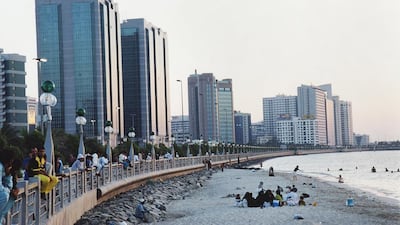Abu Dhabi has come a long way over the past three decades, with a pace of expansion and development almost unmatched by that anywhere else in the world.
It was cooler than normal in Abu Dhabi that October evening in 1985. Along the Corniche Road, people gathered to lean on the railings of the sea wall or perhaps to venture on to the narrow strip of coarse sand below, to swim or to picnic.
Others arranged to meet at the foot of the city’s most popular landmark, the huge Volcano Fountain, where at night, coloured lights made the water flow like lava.
For the young, or the young at heart, there was bowling and skating at the Tourist Club leisure complex, with a ripple of excitement with the rumour that Super Mario Brothers had finally arrived at Electric Electronic Games.
All this scene needs is an appearance by DeLorean sports car, or perhaps even a gold and white Nissan taxi, modified with a time-travelling flux capacitor.
October 21, 2015 is the date in which the film Back to the Future is set. The stars of the film, a young Michael J Fox as Marty McFly and Christopher Lloyd as mad scientist “Doc”, journey 30 years from the world of 1985.
They emerge in a world of scientific wonders, but still anchored in the familiar. The California town of Hill Valley is now a place of weird fashions, flying cars and hovering skateboards, but Courthouse Square and its famous clock remain as landmarks.
Now imagine a time traveller from Abu Dhabi leaving in October 1985 and arriving today.
It is a fair bet that at first, they would have absolutely no idea where they were.
Like Dubai, the city has utterly transformed in just 30 years, in a manner almost unmatched by anywhere else in the world.
Those crowds on that pleasant evening in 1985 would now be able to enjoy the vast expanse of the new Corniche Public Beach. But the Volcano Fountain is long gone, demolished in 2004 for a road expansion, as have Electric Electronic Games and Tourist Club, whose name continued as a district until two years ago, when it was changed by official decree to Al Zahiyah.
Also gone are the gold and white taxis, along with their colourful, if sometimes erratic, Pashtun drivers. The city now has a fleet of silver taxis, with uniformed drivers and a dedicated Mercedes to service the airport, which at least is still in the same place.
The taxis of 2015 can now be hailed with the press of a few smart phone buttons, to a location pre stored in a GPS system.
There are public buses now, although the familiar dirham coin is no longer any use for fares since the adoption of prepaid travel cards.
The Abu Dhabi of 1985 was essentially constrained by the island where it began. Yas Island did not exist – it was created by dredging as part of the F1 circuit and Saadiyat was known only for its greenhouses, the site of an experiment to grow cucumbers and tomatoes using hydroponic irrigation.
The bones of the city remain, though, in its original grid plan of roads and city blocks laid down by Sheikh Zayed in the 1970s, even if many of the former now have new names. So if our time traveller can grasp this, they will be able to venture abroad to take in the marvels of Abu Dhabi 2015.
They will find the Intercontinental Hotel, opened in 1980 as the height of luxury, but also the Emirates Palace and a constellation of five-star resorts. Something called Nation Towers now looms over the familiar Hilton on the Corniche, which has acquired several extra lanes, sweeping aside landmarks like the Pearl Fountain and the Clocktower Roundabout in the process.
What was the last word in shopping in 1985, the Hamdan Centre, now seems a little shabby. Inside, a few businesses still provide a connection that has survived three decades, like Kings Recording, opened in 1983, where vinyl records and cassette tapes by Demis Roussos and Cliff Richard still fill a back wall.
The visitor from 1985 will search in vain for the old souq, demolished after it was badly damaged in a fire in 2007. After a while, they may realise that the spot is now occupied by the Central Market and the World Trade Centre Mall.
Abu Dhabi 2015 is a city of malls, from the Marina Mall, which opened in 2001 to the new Yas Mall which will soon mark its first year of operation.
In the city of 1985, a dining experience might be a visit to the Kentucky Fried Chicken near Airport Park or one of the now almost forgotten Wimpey burger bars. Today, you could eat at different restaurant lunch and dinner for a year and still have room for more. Food can be ordered on iPads and delivered on a mini roller coaster or conveyor belt. At least the original KFC is still there.
Abu Dhabi has also become a city of towers. In 1985, the tallest building was the 20-storey high Novotel Centre on Hamdan Street. Today, it is the 381-metre -tall Burj Mohammed bin Rashid Tower, sharing the skyline with the 324 metre landmark, the 312 metre Sky Tower and complex of Etihad Towers near the Emirates Palace that reach up to 305 metres.
Other buildings will catch the eye of our time traveller, like the leaning Capital Gate or the giant mint that is the Aldar Headquarters on land that 30 years ago would have been empty desert on the road to Dubai.
Jumping back into the DeLorean, a visitor from 1985 might return full of stories of the wonders of 2015. Or they might jump forward another 30 years, to 2045 and arrive in another city beyond all our present imaginations.
plangton@thenational.ae


